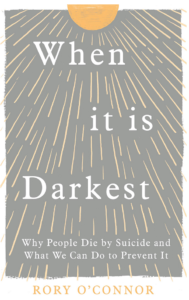Suicide is a leading cause of death and can be mitigated with suicide prevention steps and open discussions on mental health. September is National Suicide Prevention Month, with September 10 designated as World Suicide Prevention Day and the week (September 10 to 16) focused on building suicide awareness and reducing stigma around death by suicide.
Dr. Rory O’ Connor, a Professor of Health Psychology at the University of Glasgow, where he heads the Suicide Behaviour Research Laboratory, notes that it’s a common and harmful myth that asking someone if he has suicidal thoughts will plant the idea into his head. Rather, asking this difficult question could instead lead the person to get the help needed.

In his book, When It is Darkest: Why People Die by Suicide and What We Can Do to Prevent It, Dr. O’ Connor points out:
1. Suicide rates increase in warmer months, not colder months.
2. Sudden and unexplained improvement in mood – in a person who has suffered a depressive episode – might be a warning sign.
3. A major setback or loss in status or relationships can trigger suicidal thoughts, even if the person has not previously experienced depression or other mental health issues.
4. Suicide risk is affected by a wide range of conditions, including individual factors (like biology and brain health) and environmental factors (like cultural and social contexts).
5. The motivational model of suicide behavior involves three parts: the premotivational phase, the motivational phase, and the volitional phase. Not everyone who has suicidal thoughts in the premotivational phase moves to the motivational phase (where they have suicidal ideation or intention formulation) or the volitional phase (where they engage in suicidal acts or behavior, which may be fatal or non-fatal).
6. People with high social perfectionism have thin psychological skin such that when the bows and arrows of life hit them, their skin is much more likely to be pierced metaphorically. Thus, they are more inclined to feel defeated or humiliated and begin to have suicidal thoughts or behaviors.
7. People end their life to manage unbearable pain when they see no other solution to end the pain.
Unwanted social isolation and chronic loneliness have a dramatic, negative effect on a person’s mental wellness, emotional well-being and physical health. But choosing to engage in alone time through solitude can be therapeutic and restorative. Depending on the circumstances, solitude can be one effective route to deal with loneliness and the mental health issues that accompanies it.
To learn more, check out my video, Solitude: The Overlooked Path to Move Through Loneliness on The Incrementalist YouTube channel. Or listen to the podcast episode or read the transcript.
While it’s essential to have support from loved ones, friends, confidantes and professionals when dealing with suicidal thoughts, it’s equally important to be able to draw from one’s own inner reserves to navigate tough times. Reaching out for support starts with processing your own thoughts and feelings and knowing when you really need help.
# # #
Dyan Williams is a solo lawyer who practices U.S. immigration law and legal ethics at Dyan Williams Law PLLC. She is also a productivity coach who helps working parents, lawyers, small business owners and other busy people turn their ideas into action, reduce overwhelm, and focus on what truly matters. She is the author of The Incrementalist: A Simple Productivity System to Create Big Results in Small Steps.
